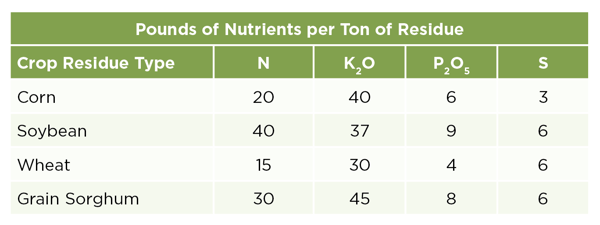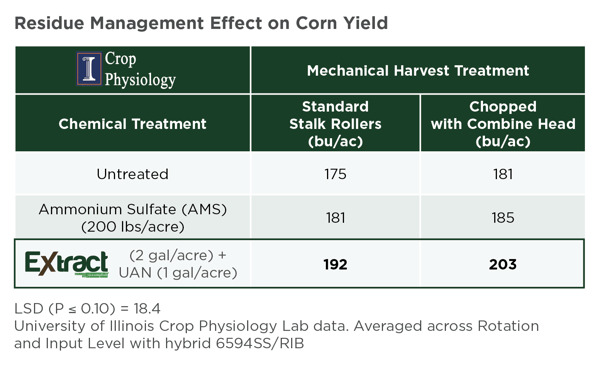By Steve Roehl, Sr. Technical Sales Agronomist, Nutrien Ag Solutions
At harvest, impressive corn yields also leave behind an impressive amount of leaf, stalk and root mass material in the form of stover or residue. While some may call this "corn trash", the sage farmer and agronomist knows that residue is actually a treasure rich in essential crop nutrients, including nitrogen (N), potassium (in the form of K2O), phosphorus (in the form of P2O5), and sulfur (S).

Crop residue also poses some challenges. Fields with heavy residue levels can be slower to warm in the spring and can pose issues related to planting (e.g., stalks and root balls can hamper planter disc openers and depth-gauge wheels) and crop establishment. In addition, heavy amounts of crop residue can hinder the ability of soil microbes to release nutrients from the residue. This is especially true for nitrogen and sulfur, which are effectively "tied up" (immobilized) by soil microbes that use them as a food source to break down residue. These immobilized nutrients only become available to the crop once the microbes finish digesting the residue and release (mineralize) the nutrients to the soil.
For these reasons, some forethought about residue and nutrient management this fall can pay dividends to your 2023 crop. For years, Nutrien Ag Solutions customers have utilized a fall or spring application of Extract PBA to maximize nutrient release from crop residues and the soil, extend the availability of nutrients later into the season, and optimize yield potential. This biochemical-based technology is an effective way to release bound nutrients while also making seedbed preparation and planting processes more effective in the spring.
A planned application of Extract PBA at 1.5-2 gal/acre in the fall with UAN will provide a food supply for residue-decomposing microbes, jumpstarting the breakdown of heavy residue while also mineralizing nutrients from the residue and soil for the next season's crop to use.
Studies conducted several years ago by Dr. Fred Below and Alison Vogel at the University of Illinois provide insight into the potential value of complimenting a corn residue management strategy with Extract PBA. In that research on continuous corn, corn residue was first mechanically treated with standard stalk rollers or chopped using the combine head. It then received either 1.) no further treatment or 2.) chemical treatment in the form of ammonium sulfate (AMS, 200 lbs/acre) or Extract PBA (2 gal/acre) plus UAN (1 gal/acre). At the following corn harvest, the use of Extract PBA with UAN in hybrid 6594SS/RIB led to the highest yield increases across both mechanical treatments compared to either no chemical treatment or to AMS alone, as shown in the table below.
 The value of Extract PBA does not end with the breakdown of crop residue and release of nutrients. It also provides timely and efficient release of nutrients in liquid fertilizer sources and those already in the soil, helping you unlock even more nutrition for your crops.
The value of Extract PBA does not end with the breakdown of crop residue and release of nutrients. It also provides timely and efficient release of nutrients in liquid fertilizer sources and those already in the soil, helping you unlock even more nutrition for your crops.
Learn more about this biocatalyst technology by downloading the Extract PBA booklet.






